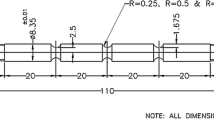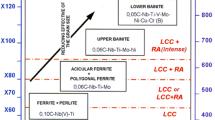Abstract
In this study, a 0.4-1.6 mm deep semicircular crack was machined in DNV F690 offshore structural steel with an aspect ratio (As) of 1.0. After needle peening (NP), four-point bending fatigue tests were conducted. The fatigue limit estimated using the equation proposed by Ando et al. decreased with increasing crack size, but agreed with that obtained in the four-point bending fatigue test. The compressive residual stress increased the fatigue limit of the NP smooth and crack specimens. The fatigue limit of the NP crack specimen with a crack depth a = 0.8 mm was over 95 % of that of the smooth specimen. Semicircular cracks with crack depths up to a = 0.8 mm could be rendered harmless by NP, however, this was not the case for the NP crack specimen having a = 1.2 mm. It was estimated that the harmless crack depth of the NP crack specimen was a = 1.14 mm.
Similar content being viewed by others
Abbreviations
- β :
-
Shape correction factor under bending stress
- σ a :
-
Applied stress amplitude
- σ r, max :
-
Maximum compressive residual stress
- σ r, s :
-
Compressive residual stress at the outermost surface
- Δσ w :
-
Fatigue limit of the non- NP smooth specimen
- Δσ wc :
-
Fatigue limit of the cracked specimen
- K r :
-
Stress intensity factor due to compressive residual stress
- ΔK ap :
-
Stress intensity factor range under applied stress
- ΔK ap(a) :
-
Stress intensity factor range based on the crack depth due to applied stress
- ΔK th :
-
Stress intensity factor for a particular crack
- ΔK th(s) :
-
Threshold stress intensity factor range for small cracks
- ΔK th(s)A :
-
Threshold stress intensity factor range at the deepest point for small cracks
- ΔK th(l) :
-
Threshold stress intensity factor range for large cracks
- As :
-
Aspect ratio
- CT :
-
Compact tension specimen
- NP :
-
Needle peening
- non-NP :
-
Non needle peened specimen
- PPP :
-
Portable pneumatic needle-peening equipment
- a :
-
Crack depth of a semicircular crack on a finite plate
- a hlm :
-
Maximum harmless crack depth
- c :
-
Half of the crack length of a semicircular crack
- 2c :
-
Crack length of the semicircular crack
- d max :
-
Depth of maximum compressive residual stress
- d 0 :
-
Maximum depth of compressive residual stress
- 2l :
-
Through crack length on an infinite plate
- l e :
-
Equivalent half crack length
- R :
-
Stress ratio
- t :
-
Plate thickness
- 2w :
-
Plate width
References
Y. T. Shin, Y. J. Jo and D. G. Seo, Application of engineering critical assessment method in the development stage of welding consumables, Journal of Welding and Joining, 34 (2016) 16–19.
J. Yasuda, K. Takahashi and H. Okada, Improvement of fatigue limit by shot peening for high strength steel containing a crack-like surface defect, influence of stress ratio, International Journal of Structural Integrity, 5 (2014) 45–59.
M. Nakagawa, K. Takahashi, T. Osada, H. Okada and H. Koike, Improvement in fatigue limit by shot peening for high-strength steel containing crack-like surface defect (influence of surface crack aspect ratio), Transactions of JSSE, 59 (2014) 13–18.
K. Takahashi, T. Amano, K. Ando and F. Takahashi, Improvement of fatigue limit by shot peening for high-strength steel containing a crack-like surface defect, International Journal of Structural Integrity, 2 (2011) 281–292.
K. Takahashi, H. Okada and K. Ando, Effects of shot peening on the torsional fatigue limit of high-strength steel containing an artificial surface defect, International Journal of Structural Integrity, 3 (2012) 274–284.
K. Houjou, K. Takahashi and K. Ando, Improvement of fatigue limit by shot peening for high-tensile strength steel containing a crack in the stress concentration zone, International Journal of Structural Integrity, 4 (2013) 258–266.
J. Yasuda, K. Takahashi and H. Okada, Improvement of fatigue limit by shot peening for high-strength steel containing a crack like surface defect -influence of stress ratio, International Journal of Structural Integrity, 5 (2014) 45–59.
K. Takahashi, H. Osedo, T. Suzuki and S. Fukuda, Fatigue strength improvement of an aluminum alloy with a crack-like surface defect using shot peening and cavitation peening, Engineering Fracture Mechanics, 193 (2018) 151–161.
R. Fueki, K. Takahashi and M. Handa, Fatigue limit improvement and rendering defects harmless by needle peening for high tensile steel welded joint, Metals, 9 (2019) 143.
P. Paris, M. P. Gomez and W. E. Anderson, A rational analytic theory of fatigue, The Trend in Engineering, 13 (1961) 9–14.
P. Paris and F. Erdogan, A critical analysis of crack propagation laws, Journal of Basic Engineering, 85 (1963) 528–533.
M. H. EI Haddad, T. H. Topper and K. N. Smith, Prediction of non-propagating cracks, Engineering Fracture Mechanics, 11 (1979) 573–584.
A. Tange, T. Akutu and N. Takamura, Relation between shot-peening residual stress distribution and fatigue crack propagation life in spring steel, Transactions of JSSE, 1991 (1991) 47–53.
K. Ando, R. Fueki, K. W. Nam, K. Matsui and K. Takahashi, A study on the unification of the threshold stress intensity factor for micro crack growth, Japan Society of Spring Engineers, 64 (2019) 39–44.
K. Ando, K. W. Nam, M. H. Kim, T. Ishii and K. Takahashi, Analysis of peculiar fatigue fracture behavior of shot peened steels focusing on threshold stress intensity factor range, Japan Society of Spring Engineers, 65 (2020) 35–41.
K. Ando, K. W. Nam, M. H. Kim and K. Takahashi, Improvement of reliability of fatigue properties of high strength steel applying surface crack non-damaging technology, Journal of High Pressure Institute of Japan, 58 (2020) 263–271.
K. Ando, M. H. Kim and K. W. Nam, Proposal for a new threshold stress intensity factor range equation for fatigue crack propagation and a study on the analysis of peculiar fracture behavior of shot peened materials by its application, Fatigue & Fracture of Engineering Materials and Structures, 45 (2021) 133–139.
K. W. Nam, W. G Lee and S. H. Ahn, The evaluation of the threshold stress intensity factor and the fatigue limit of surface-cracked specimen considering the surface condition, International Journal of Engineering Research and Technology, 12 (2019) 802–808.
H. S. Park, M. H. Kim and K. W. Nam, A study on the threshold stress intensity factor and fatigue limit of short crack growth, Trans. Korean Soc. Mech. Eng. A, 44(11) (2020) 781–786.
K. Houjou, K. Takahashi, K. Ando and K. Otsuka, Improvement of fatigue limit and rendering crack harmless by over-moment loading for spring steel containing a crack in the stress concentration zone, Transactions of the JSME A, 78 (2012) 1266–1274.
J. C. Newman Jr. and I. S. Raju, An empirical stress-intensity factor equation for the surface crack, Engineering Fractured Mechanics, 15 (1981) 185–192.
API Recommended Practice 579, Fitness for Service, American Petroleum Institute, Washington, D.C. (2000) C3–C10.
Acknowledgments
This research was supported by the Basic Science Research Program through the National Research Foundation of Korea (NRF) funded by the Ministry of Education (NRF-2019R1I1A3A 01059120).
The authors would like to acknowledge Mr. Yuta Kogishi, a graduate student at Yokohama National University, for his help with the measurement of residual stress.
Author information
Authors and Affiliations
Corresponding author
Additional information
Min-Heon Kim is a graduate student at Pukyong National University, Busan, Korea. He conducts research on the improvement of fatigue limits and on harmless cracks on metallic materials.
Won-Gu Lee is a graduate student at Pukyong National University, Busan, Korea. His research comprises the evaluation of the fatigue life and safety of offshore structures.
Cheol-Su Kim is currently working at the Eco-Friendly Transport System Research Institute, Pukyong National University, Busan, Korea. He is interested in evaluating the strengths of defects.
Koji Takahashi is working in the Division of Materials Science and Chemical Engineering, Yokohama National University, Yokohama, Japan. His research fields are metal fatigue, shot peening, self-healing materials, structural ceramics, and stress analyses.
Mitsuru Handa is working at Toyo Seiko Co. Ltd., Aiichi, Japan. He is interested in shot peening and material strength.
Ki-Woo Nam (Ph.D.) is working in the Department of Materials Science and Engineering, Pukyong National University, Busan, Korea. His research fields are crack healing and harmless cracks on structural components.
Rights and permissions
About this article
Cite this article
Kim, MH., Lee, WG., Kim, CS. et al. Evaluation of fatigue limit and harmless crack size of needle peened offshore structure steel F690. J Mech Sci Technol 35, 3855–3862 (2021). https://doi.org/10.1007/s12206-021-2109-4
Received:
Revised:
Accepted:
Published:
Issue Date:
DOI: https://doi.org/10.1007/s12206-021-2109-4




